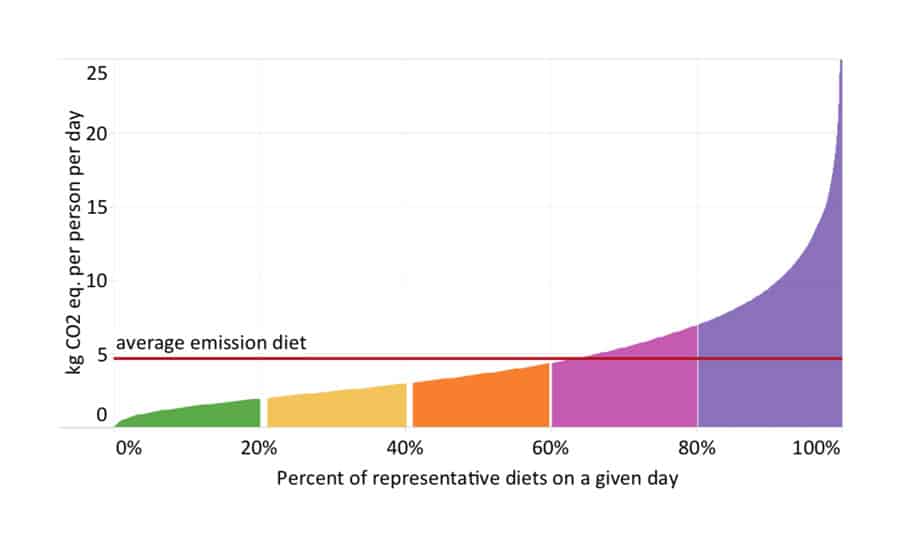On any given day, 20 percent of Americans account for nearly half of US diet-related greenhouse gas emissions, and eating lots of beef is largely responsible, according to a new study.
To estimate the impact of US dietary choices on greenhouse gas emissions, the researchers built a database that assessed the environmental impacts involved in producing more than 300 types of food. Then they linked the database to the findings of a nationally representative, one-day dietary recall survey involving more than 16,000 American adults.
They ranked the diets by their associated greenhouse gas emissions, from lowest to highest, then divided them into five equal groups, or quintiles. The researchers found that the 20 percent of US diets with the highest carbon footprint accounted for 46 percent of total diet-related greenhouse emissions.
The highest-impact group was responsible for about eight times more emissions than the lowest quintile of diets. And beef consumption accounted for 72 percent of the emissions difference between the highest and lowest groups, according to the study.
“A big take home message for me is the fact that high-impact diets are such a large part of the overall contribution to food-related greenhouse gases,” says Martin Heller of the University of Michigan, first author of the paper in the journal Environmental Research Letters.

How diets could shift
The study estimates the greenhouse gas emissions associated with food production only. Emissions related to the processing, packaging, distribution, refrigeration, and cooking of those foods were not part of the study but would likely increase total emissions by 30 percent or more, Heller says.
“Reducing the impact of our diets—by eating fewer calories and less animal-based foods—could achieve significant reductions in greenhouse gas emissions in the United States. It’s climate action that is accessible to everyone, because we all decide on a daily basis what we eat,” says Heller, a researcher at the University of Michigan Center for Sustainable Systems in the School for Environment and Sustainability.
If Americans in the highest-impact group shifted their diets to align with the US average—by consuming fewer overall calories and relying less on meat—the one-day greenhouse-gas emissions reduction would be equivalent to eliminating 661 million passenger-vehicle miles, according to the researchers.
Should reducing food waste start with meat?
That hypothetical diet shift, if implemented every day of the year and accompanied by equivalent shifts in domestic food production, would achieve nearly 10 percent of the emissions reductions needed for the United States to meet its targets under the Paris climate accord, the authors write.
Though President Trump announced his intention to withdraw the United States from the accord, many states and municipalities are still working to meet the emissions targets.
What’s so bad about beef?
In the United States in 2010, food production was responsible for about 8 percent of the nation’s heat-trapping greenhouse gas emissions. In general, animal-based foods are responsible for more greenhouse gas emissions per pound than plant-based foods. The production of both beef cattle and dairy cows is tied to especially high emissions levels.
For starters, cows don’t efficiently convert plant-based feed into muscle or milk, so they must eat lots of feed. Growing that feed often involves the use of fertilizers and other substances manufactured through energy-intensive processes. And then there’s the fuel that farm equipment uses.
In addition, cows burp lots of methane, and their manure also releases this potent greenhouse gas.
Lots of red meat and poultry tied to diabetes risk
“Previous studies of diet-related greenhouse gas emissions have focused mainly on the average diet in a given country. This study is the first in the United States to look instead at self-reported dietary choices of a nationally representative sample of thousands of Americans,” says Diego Rose, principal investigator on the project and a professor of nutrition and food security at Tulane University’s School of Public Health and Tropical Medicine.
By linking their database of environmental impacts to the individual, self-reported diets in the National Health and Nutrition Examination Survey, the researchers were able to estimate the distribution of diet-related impacts across the entire US population on a given day.
They found that Americans in the highest-impact quintile consumed more than twice as many calories on a given day—2,984 versus 1,323—than those in the bottom 20 percent. But even when the findings were adjusted for caloric intake, the highest-impact quintile was still responsible for five times more emissions than the lowest-impact group.
Meat accounted for 70 percent of the food-associated greenhouse gas emissions in the highest-impact group but only 27 percent in the lowest-impact group.
Funding for the work came from the Wellcome Trust.
Source: University of Michigan and Tulane University



